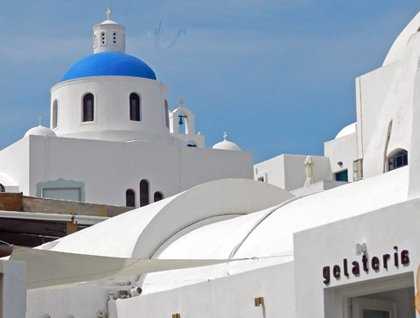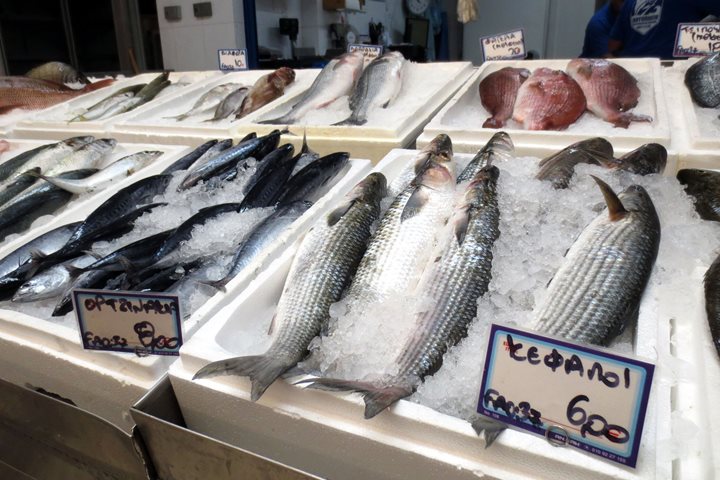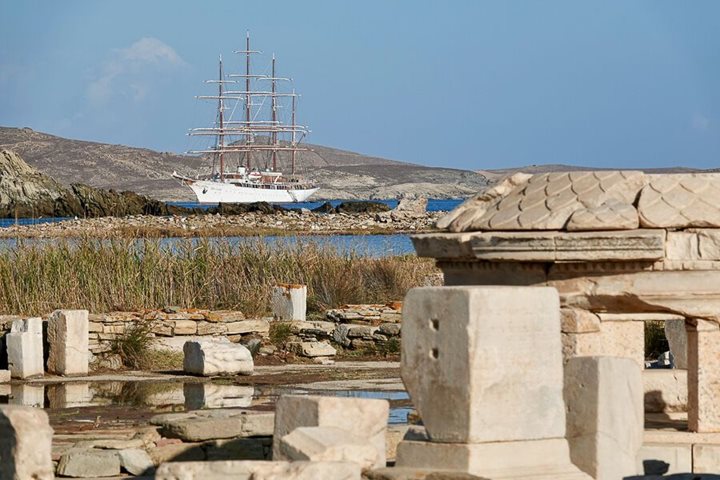Today we spent the entire day at the fabled Aegean island of Santorini, named by the Venetians after St. Irene, and called for centuries by the Greeks, Thira. Santorini is a shield volcano comprised of layer after layer of alternating black basaltic lava and either red cinder layers or white ash or ignimbrite layers. A ring of islands surround a collapsed caldera which was formed after an extremely large eruption in the 17th century BC.
The island is a favorite for visitors to the Aegean, but today there were no cruise ships in the caldera and we had the island largely to ourselves. We first went ashore by local tender and drove to the north end of the island to the village of Oia where the bright white-washed walls of the buildings perfectly set off the blue domes of the Orthodox churches punctuating the skyline. There are many very nice galleries and shops in Oia and we had time to visit many of them before heading to our lunch in the small town of Pirgos. Our lunch of mezedes made mainly from local vegetables was delicious and a thoroughly delightful experience.
After lunch we visited the Museum of Pre-History which displays an excellent collection of Minoan and Cycladian artifacts. Particularly noteworthy are the frescos from the ancient Minoan town of Akrotiri which are amazingly well preserved from their 18th to 17th century BC origins, as well as a beautiful golden ibex, which we could imagine was dropped by some Minoan running to escape the volcanic eruption of the island in 1628 BC. The eruption which formed the current archipelago was certainly one of the largest in human history, rivaling those of Krakatoa and Tambora and exceeding that of Mt. St. Helens by perhaps one hundred thousand times. The eruption also was certainly devastating to Minoan civilization here, but that culture continued, especially on Crete, for many more decades at least.
In the center of the caldera are two islands which are the site of the current volcanic activity, Nea Kameni and Palea Kameni (New and Old Burnt Islands, respectively). Nea Kameni last erupted in 1950 AD and displays very fresh-looking lava on its flanks. When we were ready to return to Sea Cloud, patiently resting at anchor just offshore, some of us descended from the crater rim by the relatively new cable car while others chose the more traditional transport provided by local donkeys.
In the evening we heard a description by our expedition leader, Tom O’Brien, of the magnificent history of Sea Cloud, through her many roles and incarnations.We then took a tour of the original staterooms in which Marjorie Merriweather Post, heir to the General Foods fortune and her husband E. F. Hutton, stock market tycoon and designer of the vessel, relaxed at leisure, accompanied by a few of their friends and their nanny and butler, and attended by a crew of 72. We all feel some of the reflected opulence from those storied times as we sail aboard this wonderful maritime legend.







